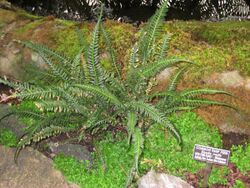Biology:Doodia media
| Doodia media | |
|---|---|

| |
| Scientific classification Error creating thumbnail: Unable to save thumbnail to destination
| |
| Kingdom: | Plantae |
| Clade: | Tracheophytes |
| Division: | Polypodiophyta |
| Class: | Polypodiopsida |
| Order: | Polypodiales |
| Suborder: | Aspleniineae |
| Family: | Blechnaceae |
| Genus: | Doodia |
| Species: | D. media
|
| Binomial name | |
| Doodia media R.Br.[1]
| |
| Synonyms[1] | |
| |
Doodia media, also known as rasp fern (or pukupuku in Māori),[2] is a fern species in the family Blechnaceae. The species was formally described by botanist Robert Brown in 1810.[3][4] Distribution of the species includes New Zealand's North Island and the upper part of the South Island (Nelson and Marlborough).[2] It is also found in Australia and Lord Howe Island.[5]
Young fronds contain flavonoids that protect them from ultraviolet radiation and give them a pink colour.[2]
Phylogenic studies have shown that the genus Doodia is embedded within the paraphyletic genus Blechnum,[6] when that genus is broadly circumscribed. Christenhusz et al., 2011, therefore reassigned all Doodia species to Blechnum. Doodia media R.Br. was transferred to Blechnum medium and Doodia media subsp. australis (Doodia australis) was transferred to Blechnum parrisii.[7] Other sources, such as World Ferns, based on the Pteridophyte Phylogeny Group classification, split Blechnum, accepting Doodia.[1]
References
- ↑ 1.0 1.1 1.2 Hassler, Michael (2004–2021), Genus Doodia, https://www.worldplants.de/world-ferns/ferns-and-lycophytes-list#g-240, retrieved 2021-09-24
- ↑ 2.0 2.1 2.2 Crowe, A. (1994). Which Native Fern?, p. 37. Auckland: Viking. ISBN:0-670-85549-9.
- ↑ "Doodia media". Australian Plant Name Index (APNI), IBIS database. Centre for Plant Biodiversity Research, Australian Government, Canberra. http://www.anbg.gov.au/cgi-bin/apni?TAXON_NAME=Doodia+media. Retrieved 17 March 2012.
- ↑ New Zealand journal of botany. 2006
- ↑ "PlantNET - FloraOnline". http://plantnet.rbgsyd.nsw.gov.au/cgi-bin/NSWfl.pl?page=nswfl&lvl=sp&name=Doodia~australis.
- ↑ Carl J. Rothfels; Anders Larsson; Li-Yaung Kuo; Petra Korall; Wen- Liang Chiou; Kathleen M. Pryer (2012). "Overcoming Deep Roots, Fast Rates, and Short Internodes to Resolve the Ancient Rapid Radiation of Eupolypod II Ferns". Systematic Biology 61 (1): 490–509. doi:10.1093/sysbio/sys001. PMID 22223449.
- ↑ Maarten J. M. Christenhusz; Xian-Chun Zhang; Harald Schneider (2011). "A linear sequence of extant families and genera of lycophytes and ferns". Phytotaxa 19: 7–54. doi:10.11646/phytotaxa.19.1.2. http://www.mapress.com/phytotaxa/content/2011/f/pt00019p054.pdf.
- New Zealand journal of botany. 2006. vol. 18
Wikidata ☰ Q5296982 entry
 |


